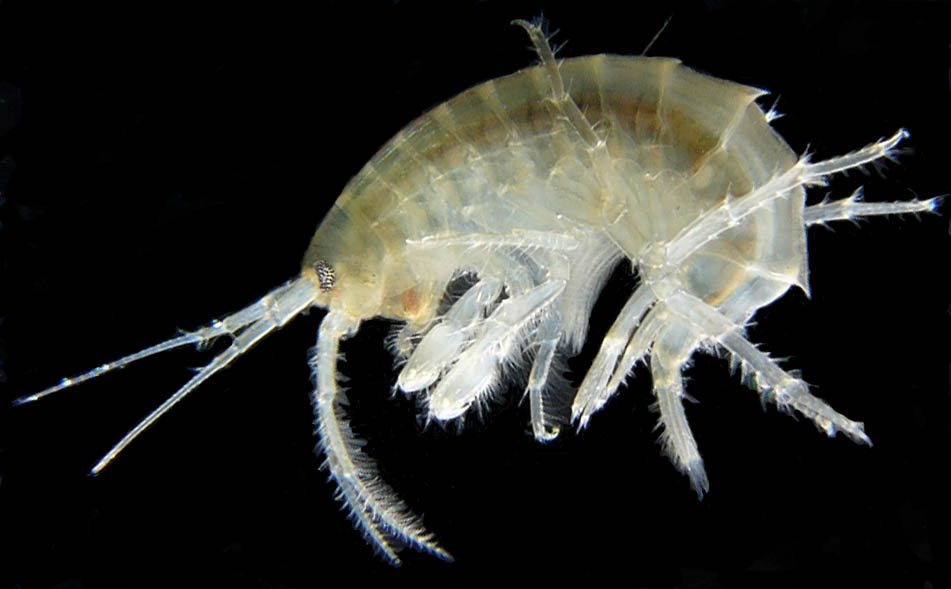- Amphipoda
image_width = 250px
image_caption = A gammarid amphipod ("Gammarus roeselii")
regnum =Animal ia
phylum =Arthropod a
subphylum = Crustacea
classis =Malacostraca
superordo =Peracarida
ordo = Amphipoda
ordo_authority = Latreille, 1816
subdivision_ranks = Sub-orders
subdivision =Gammaridea Corophiidea Hyperiidea Ingolfiellidea Amphipoda (amphipods) are an order of animals that includes over 7,000 described
species ofshrimp -likecrustacean s ranging from 1 mm to 140 mm in length.Most amphipods are
marine ; although a small number of species are limnic or terrestrial. Marine amphipods may bepelagic (living in the water column) orbenthic (living on the ocean bottom). Pelagic amphipods are eaten byseabird s, fish, and marine mammals. Terrestrial amphipods such as sand fleas can often be seen amongst sand and pebbles or on beaches.Distribution and life
Many species of pelagic amphipods are mutualistic or (usually) parasitic, living in association with
jellyfish andsalp s. "Phronima " is a relatively common genus of pelagic amphipod that kills and cleans out the barrel-shaped body of asalp to live inside and raise its young.Of the relatively few species of free-living,
plankton ic amphipods, the most abundant of all is "Themisto gaudichaudii ". Living in theSouthern Ocean , this amphipod congregates in dense swarms, where it is a voracious predator ofcopepod s and other small members of thezooplankton .After
copepod s,krill andsalp s, which are mostlyherbivorous , thecarnivorous "Themisto" is the most abundant member of themesozooplankton in theSouthern Ocean .In cold seas, benthic amphipods are enormously diverse and abundant. In the
Southern Ocean , amphipods are the most abundant benthic crustaceans. Some are grazers, many areomnivorous , some even act aspiranha -like scavengers, quickly cleaning the carcasses of dead tissue. Amphipods are one of the few animal groups frequently seen whensubmarine s venture to the deepest parts of the oceans. Other benthic amphipods are the primary food ofGray Whale s. Certain species of pelagic amphipods make vertical migrations diurnally.A ship hull fouling species of amphipod common to Atlantic and estuarine waters is "
Jassa falcata ".External links
* [http://www.tafi.org.au/zooplankton/imagekey/malacostraca/peracarida/amphipoda/amphipoda.html Amphipoda fact sheet - Guide to the marine zooplankton of south eastern Australia]
* [http://www.britannica.com/EBchecked/topic/21587/amphipod Amphipod.] Britannica (2008)
* [http://www.crustacea.net/crustace/amphipoda/index.htm Amphipoda page at www.crustacea.net] includes a list of families
* [http://www.imv.uit.no/amphipod/index.html The Amphipod Home Page]
* [http://www.imv.uit.no/ommuseet/enheter/zoo/wim/a_e.html A database of amphipod literature]
* [http://creatures.ifas.ufl.edu/misc/amphipods.htm terrestrial amphipods] on theUF / IFAS Featured Creatures Web site
* [http://niphargus.info The Niphargus page] All about the amphipod genusNiphargus
Wikimedia Foundation. 2010.

